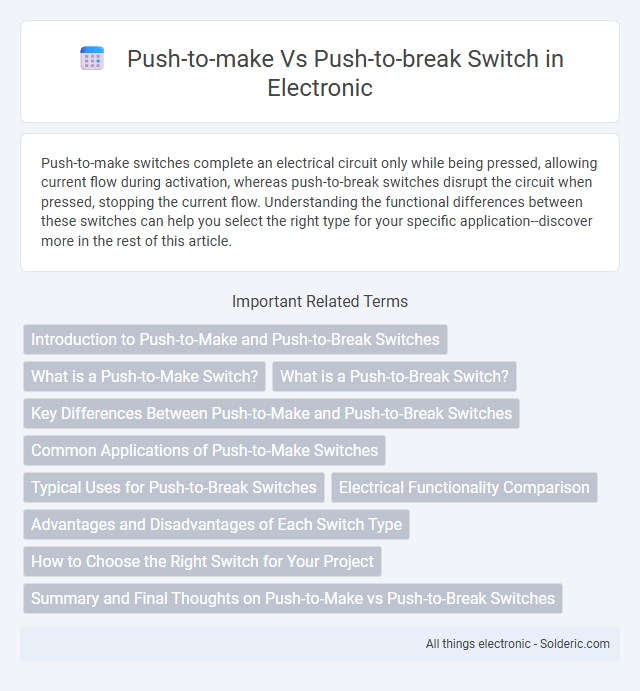Push-to-make switches complete an electrical circuit only while being pressed, allowing current flow during activation, whereas push-to-break switches disrupt the circuit when pressed, stopping the current flow. Understanding the functional differences between these switches can help you select the right type for your specific application--discover more in the rest of this article.
Comparison Table
| Feature | Push-to-Make Switch | Push-to-Break Switch |
|---|---|---|
| Definition | Completes the circuit when pressed | Breaks the circuit when pressed |
| Default State | Open circuit | Closed circuit |
| Operation | Conducts electricity only while pressed | Interrupts electricity only while pressed |
| Common Use | Momentary activation, e.g., doorbell | Emergency stop, safety interlock |
| Symbol | Usually represented by a break contact closing on press | Represented by a make contact opening on press |
Introduction to Push-to-Make and Push-to-Break Switches
Push-to-make switches close an electrical circuit when pressed, allowing current to flow only during the actuation, commonly used in doorbells and keyboards. Push-to-break switches open a circuit when pressed, interrupting current flow, often found in safety devices and power controls. Both types offer momentary control but serve opposite functions in circuit management.
What is a Push-to-Make Switch?
A push-to-make switch is a momentary contact switch that completes an electrical circuit only while it is being pressed, enabling current flow during the actuation. This type of switch is commonly used in applications requiring temporary activation, such as doorbells, keyboards, and control panels. Its default state is open, meaning no current passes through until the button is pushed and the circuit is momentarily closed.
What is a Push-to-Break Switch?
A push-to-break switch is a type of momentary switch that interrupts the electrical circuit when pressed, breaking the current flow. Unlike a push-to-make switch that completes a circuit upon activation, the push-to-break switch opens the circuit, stopping power to the connected device. Your applications requiring circuit interruption, such as safety mechanisms or reset functions, often utilize push-to-break switches for their reliable disconnection capabilities.
Key Differences Between Push-to-Make and Push-to-Break Switches
Push-to-make switches complete an electrical circuit only when pressed, allowing current to flow, whereas push-to-break switches interrupt the circuit upon pressing, stopping current flow. The key difference lies in their default states: push-to-make switches remain open until activated, while push-to-break switches stay closed until pressed. Understanding these distinctions helps you select the appropriate switch type for controlling electrical connections in devices and machinery.
Common Applications of Push-to-Make Switches
Push-to-make switches are widely used in applications requiring momentary connection, such as doorbells, computer keyboards, and control panels for machinery where temporary actuation triggers an immediate response. These switches serve as tactile inputs in electronic devices, enabling user commands in devices like calculators, digital cameras, and gaming controllers. Their reliability and quick response make them ideal for safety equipment and emergency stop buttons in industrial settings.
Typical Uses for Push-to-Break Switches
Push-to-break switches are commonly used in safety and emergency stop applications where interrupting the current flow is critical. These switches momentarily open the circuit when pressed, often found in power tool controls, machinery stop buttons, and alarm systems. Your equipment benefits from their fail-safe design, instantly halting operation to prevent accidents or damage.
Electrical Functionality Comparison
Push-to-make switches complete an electrical circuit only when pressed, allowing current to flow momentarily, which is ideal for applications requiring brief activation. Push-to-break switches disconnect the circuit when pressed, interrupting the current flow and serving as a failsafe or stop mechanism in various devices. Understanding the electrical functionality of your switch ensures proper selection based on whether you need to initiate or interrupt power within your system.
Advantages and Disadvantages of Each Switch Type
Push-to-make switches provide reliable and immediate circuit connection when pressed, making them ideal for momentary actions and user control interfaces, but they may wear out faster due to constant contact engagement. Push-to-break switches excel in safety applications by disconnecting the circuit upon pressing, preventing accidental activation; however, they can be less intuitive for users expecting the circuit to complete when pressed. Choosing between push-to-make and push-to-break switches depends on your specific control needs, balancing durability and operational clarity.
How to Choose the Right Switch for Your Project
Choosing the right switch for your project depends on the desired circuit behavior when the button is pressed. A push-to-make switch completes the circuit upon pressing, ideal for momentary activation tasks such as doorbells or reset buttons. Opt for a push-to-break switch if your project requires interrupting the circuit when pressed, commonly used in emergency stop functions to ensure safety.
Summary and Final Thoughts on Push-to-Make vs Push-to-Break Switches
Push-to-make switches complete an electrical circuit only while the button is pressed, ideal for momentary operations like doorbells or keyboards. Push-to-break switches disrupt the circuit when pressed, often used for safety or reset functions to stop current flow. Understanding your specific application helps determine whether a push-to-make or push-to-break switch fits your needs for reliable and efficient control.
push-to-make vs push-to-break switch Infographic

 solderic.com
solderic.com